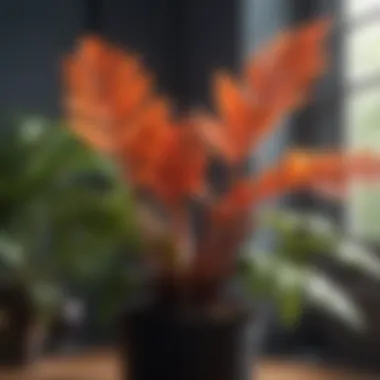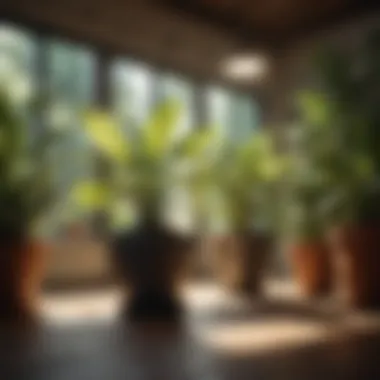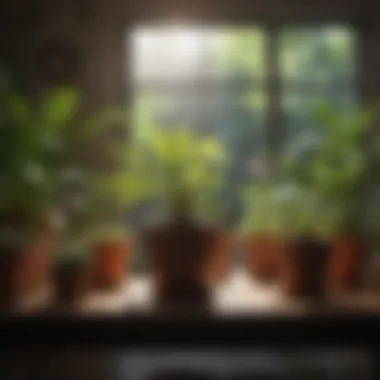The Importance of Direct Sunlight for Indoor Plants


Intro
Direct sunlight is often regarded as one of the most critical elements in maintaining healthy indoor plants. While numerous factors contribute to the overall growth of plants, none can surpass the importance of light. This article aims to dismantle the complexities of direct sunlight's role in the growth of indoor flora.
Plants, by nature, have evolved to rely on sunlight for photosynthesis, the process through which they convert light energy into chemical energy. This fundamental biological necessity signifies that without adequate light, even the most well-cared-for plants will struggle to thrive. The different light intensities and durations can greatly affect how plants develop, bloom, and even survive.
Key Points to Address
- The biological necessities of various plants regarding light exposure.
- The impact of light intensity on plant health and growth.
- Specific needs for different plant species and their optimal light conditions.
- Common challenges that indoor gardeners face in replicating natural sunlight.
- Expert tips and methods on how to provide sufficient light.
Through examining these components, readers will develop a nuanced understanding of how important direct sunlight is in cultivating a rich indoor garden.
Importance of Sunlight for Indoor Plants
The role of sunlight in the growth and development of indoor plants cannot be overstated. Sunlight is not just a source of light; it serves as the primary energy source for photosynthesis, which is essential for plant health. Understanding the significance of sunlight allows indoor gardeners to create an environment where plants can flourish.
Adequate sunlight impacts various physiological and biochemical processes in plants. Sunlight is a key player in photosynthesis, driving the conversion of carbon dioxide and water into glucose and oxygen. This process is fundamental for sustaining plant life and contributes to overall growth. When indoor plants receive the right amount of sunlight, they exhibit enhanced vigor, signifying that they are thriving rather than merely surviving.
Beyond the necessity of photosynthesis, sunlight influences the structural development of plants. The amount and quality of light dictate how a plant grows. For example, some species tend to stretch toward light, which can affect their overall shape and health. Well-lit indoor plants often develop sturdier and more robust stems, while those in low light may become leggy and weak.
Additionally, adequate sunlight plays a crucial role in the flowering and fruiting processes. Many indoor plants rely on specific light conditions to produce blooms or fruits. For instance, flowering plants may require a certain duration of light exposure to trigger their reproductive cycles. Without the appropriate amount of light, these plants may fail to flower or may produce weak, less vibrant blooms.
In summary, sunlight is not merely beneficial; it is indispensable for indoor plants. From fueling critical growth processes to shaping plant structure and promoting flowering, the impact of sunlight extends throughout a plant's lifecycle. Gardeners must pay close attention to the light requirements of their plants to ensure optimal growth and health.
Light Requirements by Plant Species
The light requirements of indoor plants can vary significantly among different species. Understanding these variances is crucial for creating optimal growing environments. Each species has adapted over time to thrive in specific light conditions, influencing their growth patterns, flowering, and overall vitality. By recognizing the light preferences of particular plants, gardeners can cultivate healthier and more beautiful indoor gardens.
Low Light Tolerant Species
Low light tolerant species are the champions of the indoor plant world. These plants can survive in dim conditions, making them ideal for spaces with limited natural light. Some examples include Snake Plant, ZZ Plant, and Pothos.
- Adaptability: These plants have adapted to thrive under low light situations. They don’t need direct sunlight and often flourish in indirect light.
- Care Requirements: Watering practices also change. Overwatering is a common error because these plants tend to need less water than their high light counterparts.
- Growth Expectations: While their growth may be slower compared to sun-loving plants, patience can reward you with resilient foliage.
"Choosing low light tolerant species can prevent discouragement for indoor gardeners who struggle with adequate sunlight exposure."
Medium Light Loving Plants
Plants that prefer medium light levels strike a balance between shade and direct sun. Varieties like Spider Plant, Peace Lily, and Philodendron fall into this category.
- Optimal Conditions: Medium light usually translates to bright, indirect sunlight. These plants can handle a few hours of filtered light but should be protected from harsh midday rays.
- Care Tips: It's essential to monitor their moisture needs closely. They appreciate consistent watering but dislike soggy soil.
- Visual Appeal: These species often exhibit vibrant greens and can add both color and texture to indoor spaces, enhancing aesthetic appeal.
High Light Demand Plants
High light demand plants are those that seek significant amounts of direct sunlight. Examples include Cacti, Succulents, and Ficus.


- Requirements: These plants thrive in south or west-facing windows where they can soak up bright, consistent light for most of the day.
- Vulnerability: Since they are accustomed to bright conditions, low light can cause poor growth and induce problems like leggy stems or lack of flowering.
- Maintenance: When providing high light, consider the temperature and humidity as well. As these plants bask in sunlight, they may require supplemental watering to counteract drying out.
Understanding the light preferences not only maximizes the potential of plant growth but also enhances the overall success of indoor gardening. Employing this knowledge will lead to fruitful results and a flourishing indoor garden.
Types of Sunlight for Indoor Plants
Understanding the different types of sunlight is crucial for providing optimal care for indoor plants. Each plant has unique light preferences that directly affect its health and growth. By identifying and utilizing the specific sunlight types, gardeners can create an environment that caters to the needs of their greenery. This knowledge fosters robust plant life, encourages flowering, and helps prevent issues related to inadequate lighting.
Direct vs. Indirect Sunlight
Direct sunlight refers to the unfiltered rays that reach a plant during the day. This light is intense and is often best suited for plants that thrive on high light levels, such as succulents and cacti. On the other hand, indirect sunlight occurs when the rays are diffused through windows or filtered by sheer curtains. Many indoor plants flourish under indirect light, including ferns and pothos.
- Benefits of Direct Sunlight:
- Considerations for Indirect Sunlight:
- Promotes vigorous growth.
- Increases photosynthesis efficiency.
- Enhances flowering in blooming species.
- Prevents leaf burn in sensitive species.
- Encourages lush foliage without excessive dryness.
- Allows for a wider selection of plants in various home settings.
Filtered Sunlight
Filtered sunlight is where direct rays pass through a barrier, such as a curtain or a tree's canopy. This light is softer and less intense compared to unfiltered sunlight. Certain plants, particularly tropical species like philodendrons and peace lilies, benefit greatly from filtered light. This type of lighting reduces the risk of leaf scorch while still providing necessary brightness for growth.
Key Points on Filtered Sunlight:
- Ideal for many indoor plants that cannot tolerate full sun.
- Provides a balance between adequate light and protection from harsh exposure.
- Creates an inviting atmosphere in indoor gardening spaces.
Artificial Light Alternatives
In cases where direct or adequate natural light is not available, artificial light becomes a necessary alternative. Using grow lights can effectively supplement sunlight for plants, ensuring they receive the right spectrum and intensity. LED lights are increasingly popular due to their energy efficiency and full-spectrum capabilities, which mimic natural sunlight.
When to Use Artificial Light:
- During winter months when daylight is limited.
- In rooms without windows or with low light exposure.
- For specific growing phases, such as germination or flowering.
Adopting a thoughtful approach to these types of sunlight will allow indoor gardeners to maximize the health and vitality of their plants. By paying attention to the specific needs of each species, and by being willing to innovate with methods like grow lights, indoor gardening can thrive even in challenging light conditions.
Measuring Light Exposure
Measuring light exposure is a critical aspect of indoor plant care. Understanding how much light your plants receive can greatly impact their overall health and growth. Different plants thrive in varying light conditions; thus, knowing the light intensity and duration helps in creating the right environment. This section will explore light meters, the concept of light intensity, and strategies for properly positioning plants to maximize their exposure to light.
Light Meters and Their Usage
Light meters are essential tools for any serious indoor gardener. They provide accurate measurements of light intensity, which is crucial for determining whether a plant is receiving adequate sunlight.
The basic principle behind a light meter involves capturing light and translating it into measurable units, typically lux or foot-candles. Using a light meter is straightforward. You simply hold it at the plant's height and point the sensor toward the light source. This will give you a clear idea of the conditions your plants are in.


Investing in a good quality light meter allows for better management of plant care. It helps identify too much or too little light, providing guidance for repositioning plants as needed. This ensures that plants receive the right amount of direct sunlight necessary for their growth stages.
Understanding Light Intensity
Light intensity refers to the strength of the light available to plants. Different species have different requirements. Some prefer high light environments, while others do well in low light.
- High Light Conditions: These plants require bright, direct sunlight for at least six hours a day. Examples include succulents and cacti.
- Medium Light Conditions: These thrive in filtered or indirect light. Plants like pothos and spider plants fall into this category.
- Low Light Conditions: Some plants can survive with minimal sunlight. These include snake plants and ferns.
It is important to regularly check the light intensity in various areas of your home. Seasonal changes can impact light availability, making it vital to adjust plant placements accordingly.
Positioning Plants for Optimal Light
The position of plants significantly affects their light exposure. Placing plants near windows or other light sources ensures they receive the necessary sunlight. However, filtering through curtains can help moderate harsh rays that might scorch leaves.
When positioning your plants, consider the following:
- West or South-facing windows typically offer the best light for sun-loving plants.
- North-facing windows provide low light, suitable for low-light species.
- Rotate pots periodically to promote even growth. Plants growing towards the light can become lopsided without regular movement.
Regularly assess the placement of your indoor plants to provide consistent light exposure for optimal health.
Understanding and measuring light exposure is essential for a successful indoor gardening experience. With the right tools and knowledge, you can ensure your plants receive the light they need to thrive.
Challenges of Providing Direct Sunlight
Providing direct sunlight for indoor plants can pose many unique challenges. While sunlight is crucial for growth, ensuring proper light conditions in indoor environments requires careful consideration. Factors such as the changing seasons, the limitations of indoor spaces, and the potential for plant diseases all play significant roles in determining how effectively plants can utilize sunlight. Understanding these challenges can help indoor gardeners manage their plants more efficiently and create healthier growing conditions.
Seasonal Changes and Their Effects
Seasonal changes can greatly affect the availability and intensity of sunlight. During winter months, days are shorter, and the angle of sunlight is lower. This can lead to inadequate light reaching indoor plants, especially those placed farther from windows. Even in summer, when sunlight is plentiful, intense heat can cause some plants to suffer from sunburn or stress. It is beneficial to monitor how seasonality alters light conditions, as this influences plant growth cycles. Adjusting the placement of plants or using supplemental lighting becomes essential.
Indoor Environment Limitations
Indoor environments impose several constraints that can complicate providing optimal sunlight. Many homes have varied window placements, which affect the amount of light entering. Items such as curtains, buildings, or trees outside can cast shadows. Additionally, indoor air temperature, humidity, and the consistency of air circulation also impact plant health. So, while a plant may receive direct sunlight, it might not thrive if other conditions are not suitable. Assessing these factors helps in creating a more suitable environment for plants to flourish.
Common Plant Diseases Due to Improper Light
Improper light exposure can lead to various plant diseases. Insufficient light may result in leggy growth, where plants stretch towards the light source, weakening stems. Conversely, too much direct sunlight can cause leaf scorch, which manifests as burnt tips or edges. Moreover, certain fungal diseases thrive in low-light situations. If plants are consistently stressed due to fluctuating light conditions, their resilience decreases, making them susceptible to pests and diseases. It is imperative to monitor plants regularly and act quickly should the signs of disease appear.
"An understanding of the challenges in providing adequate light will ultimately enhance the care and growth of indoor plants."
Gaining awareness of these challenges helps gardeners better plan for their indoor conditions, ensuring their plants receive the appropriate amounts of sunlight throughout the year.
Best Practices for Sunlight Management
Managing sunlight exposure for indoor plants is crucial for their overall health and growth. Having the right practices in place ensures that plants receive adequate light while mitigating potential downsides like scorching or inadequate growth. Highlighting these practices allows gardeners to create an environment where indoor plants can flourish, ultimately enhancing their beauty and vitality. Effective management involves not just providing light but doing so in a way that respects the unique needs of each species.


Creating a Plant Rotation Schedule
One effective method for optimizing light availability is to set up a plant rotation schedule. This practice allows indoor gardeners to periodically change the position of their plants, ensuring that each receives the right amount of sunlight. For instance, plants that prefer brighter light may be moved closer to windows, while those that thrive in lower light can be placed further away.
Establishing a schedule helps to prevent uneven growth or a lopsided appearance in plants. When plants are rotated, their growth becomes more uniform, reducing the risk of leggy or sparse foliage. This practice is especially beneficial during seasonal changes when sunlight availability can fluctuate significantly. To implement this:
- Decide on a Rotation Frequency: Consider rotating every week or every two weeks.
- Keep Track of Growth: Make observations on each plant’s growth in different spots.
- Adjust Based on Seasons: Move plants accordingly as sunlight alters with changing seasons.
By adopting a systematic approach to rotation, gardeners can cater to the specific lighting needs of different species effectively.
Using Reflective Surfaces
Reflective surfaces can amplify sunlight and enhance the growth conditions for indoor plants. Mirrors, aluminum foil, or even light-colored walls can redirect light toward your plants. This technique increases the overall light intensity that your plants receive without needing to move them directly into bright sunlight.
Using reflective surfaces has multiple benefits:
- Maximized Light Use: Plants can absorb additional light without being burned by overly direct sunlight.
- Uniform Light Distribution: Helps ensure that all areas of the plant receive adequate illumination, promoting even growth.
- Effective for Space Utilization: Ideal for small living areas where sunlight might be limited.
To effectively implement this practice:
- Identify Perfect Locations: Find areas where light can be efficiently reflected onto the plants.
- Experiment with Angles: Adjust the angle of reflective surfaces to find optimal positions for light movement.
- Monitor Plant Response: Observe how plants react to ensure that these surfaces are positively impacting growth.
Monitoring Plant Responses
Continually monitoring plant responses to their light conditions is fundamental to effective sunlight management. Each plant species may react differently to changes in light exposure, so being observant is key. Some plants may show signs of sunburn, yellowing leaves, or stunted growth if they receive too much sunlight. Conversely, dark green leaves and slow growth might indicate insufficient light.
Here are a few strategies for effectively monitoring plant responses:
- Keep a Growth Journal: Document changes in color, size, and leaf health.
- Set Check-In Dates: Regularly assess the general health of plants, and adjust conditions if needed.
- Use Growth Indicators: Pay attention to flowering times or leaf dropping as signs of light satisfaction or dissatisfaction.
“Regular monitoring can ensure plants are thriving, making adjustments as necessary for optimal health.”
By combining these practices, indoor gardeners can create a supportive environment that meets the specific light needs of their plants. Understanding how to manage sunlight properly can drastically improve indoor gardening outcomes.
Finale and Future Considerations
One key takeaway is the adaptation of light needs to specific plant species. As noted earlier, different plants demand different light intensities; knowing these requirements prevents many common issues, such as leggy growth or poor flowering. For example, high light demand plants like succulents require more exposure to direct sunlight than low light tolerant species like snake plants. This specificity reinforces the necessity for indoor gardeners to tailor their approach accordingly.
As indoor gardening practices evolve, understanding the practical applications of sunlight management becomes paramount. Proper placement of plants, utilization of reflective surfaces, and monitoring plant responses are strategies that can enhance light efficiency in indoor settings.
Furthermore, as urban environments become more dominant, the quest for optimal indoor lighting solutions continues. The integration of artificial light can be a vital consideration for plant care, especially during less sunny months. With advancements in technology, growers now have access to better artificial light systems that mimic the natural spectrum of sunlight.
Summary of Key Points
- Importance of Sunlight: Direct sunlight is essential for photosynthesis, plant growth, and overall health.
- Species Specificity: Different plants have distinct light requirements; understanding this is critical for successful caregiving.
- Adaptation and Flexibility: As environments change, gardeners should adapt by considering both natural and artificial light sources.
Expanding Knowledge on Plant Preferences
Expanding our understanding of unique plant preferences is critical for thriving indoor gardens. Education around which species require high, medium, or low light can significantly reduce failure rates in indoor gardening. Resources such as informative articles and gardening communities on platforms like reddit.com or facebook.com provide ample support for novice and experienced growers alike.
Additionally, investing time in learning about specific plant needs, including their responses to varying light conditions, can lead to a more rewarding gardening experience. This may include experimenting with different positions of plants to observe how they react to sunlight changes throughout the day.
Furthermore, the integration of technology like light meters can aid in quantifying light exposure, ensuring each plant receives its optimal dose. Ultimately, a proactive approach to understanding and accommodating plant preferences will pave the way for lush, flourishing indoor spaces.







